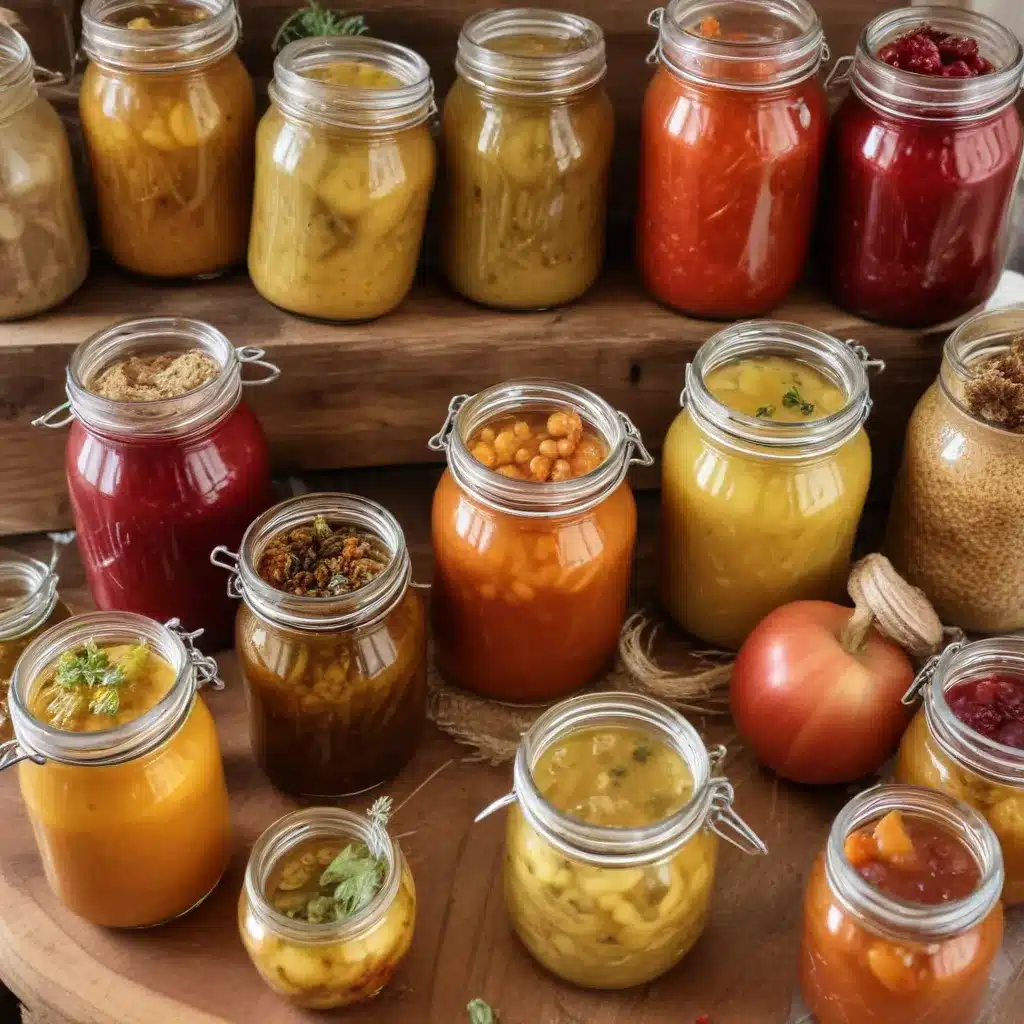
Autumn’s crisp air signals the arrival of a new season, and with it, the opportunity to savor the vibrant flavors of the harvest. As the days grow shorter and the leaves begin to change, the team at Crooked Pines Farm is busy preserving the abundant produce from our fields and orchards. One of our favorite methods? The ancient art of fermentation.
The Art of Fermentation
The Essence of Fermentation
Fermentation is a time-honored tradition that transforms simple ingredients into complex, deeply flavorful foods and beverages. At its core, fermentation is a process driven by beneficial microorganisms, such as bacteria and yeasts, that convert the natural sugars and starches in fruits, vegetables, and grains into lactic acid, alcohol, and a host of other byproducts.
Principles of Fermentation
The key to successful fermentation lies in creating an environment that favors the growth of desirable microbes while inhibiting the proliferation of harmful ones. This is typically achieved by controlling factors like temperature, pH, and oxygen levels. By mastering these principles, home fermenters can transform a wide variety of produce into tangy, crunchy, and nutritious delicacies.
Benefits of Fermentation
Beyond the captivating flavors, fermentation also offers a wealth of health benefits. The live cultures produced during fermentation are rich in probiotics, which support gut health and immune function. Fermentation also increases the bioavailability of essential nutrients, making fermented foods a nutritional powerhouse. As an added bonus, the preservation process extends the shelf life of perishable items, allowing you to enjoy the bounty of the season long after the last harvest.
Preserving the Harvest
Techniques for Preservation
At Crooked Pines Farm, we employ a variety of preservation methods to make the most of our seasonal abundance. In addition to fermentation, we also utilize techniques like canning, freezing, drying, and infusing to capture the essence of our freshly picked produce.
Selecting Produce for Fermentation
When it comes to fermentation, the possibilities are endless. Almost any fruit or vegetable can be transformed through this process, from crunchy cucumbers and fragrant herbs to sweet berries and earthy root vegetables. The key is to choose produce that is at the peak of ripeness, as the natural sugars and enzymes present will kickstart the fermentation process.
Fermenting Vegetables and Fruits
One of our favorite fermented creations is kimchi, a spicy and tangy Korean condiment made from napa cabbage, radishes, and a host of aromatic seasonings. To prepare, we simply shred the vegetables, mix them with a flavorful brine, and allow the mixture to ferment for several weeks. The result is a probiotic-rich side dish that adds a burst of flavor to everything from rice bowls to grilled meats.
For a sweeter take on fermentation, we often transform seasonal fruits like berries, peaches, and plums into vibrant shrubs and switchels. These tangy-sweet drinking vinegars not only make refreshing beverages but also serve as versatile mixers for cocktails and mocktails.
Flavors of Fermentation
Exploring Fermented Flavors
One of the joys of fermentation is the incredible depth of flavor it can impart. As the microbes do their work, they produce a symphony of sour, umami, and even sweet notes that can’t be replicated through other preservation methods. From the pungent aroma of sauerkraut to the earthy, complex notes of miso, fermented foods offer a world of culinary exploration.
Pairing Fermented Foods
The bold, assertive flavors of fermented foods make them the perfect companions to a wide range of dishes. We love to incorporate our homemade pickles, kimchi, and fermented hot sauces into grain bowls, tacos, and salads, where their tangy punch cuts through rich, creamy, or spicy elements. Fermented condiments and spreads also make excellent accompaniments to grilled meats, roasted vegetables, and artisanal breads.
Balancing Acidity and Umami
The key to successful fermented dishes is finding the right balance between acidity and umami. Too much sourness can overwhelm, while an imbalance of savory, earthy flavors can make a dish feel one-dimensional. By carefully monitoring the fermentation process and adjusting seasonings, we’re able to craft fermented components that seamlessly integrate into a wide range of culinary creations.
The Fermented Pantry
Building a Fermentation Toolkit
Embarking on your own fermentation journey doesn’t require a vast array of specialized equipment. At Crooked Pines Farm, we rely on a few essential tools, including mason jars, airlock lids, weighted fermentation weights, and a food scale to ensure precise measurements. With these simple items, you can transform the bounty of your garden or local market into a treasure trove of flavorful, probiotic-rich foods.
Storing and Aging Fermented Goods
Once your fermented creations have reached the desired flavor profile, proper storage is key to maintaining their integrity. We recommend transferring finished products to the refrigerator, where the cool temperature will slow down the fermentation process and prevent overripening. Depending on the item, fermented foods can often be enjoyed for several months or even up to a year with proper care.
Fermented Condiments and Spreads
In addition to classic fermented vegetables and fruits, we also love to play with the preservation process to create unique condiments and spreads. Fermented mustard, garlic-herb compound butter, and spicy fruit chutneys are just a few of the creative ways we like to incorporate the rich, complex flavors of fermentation into our everyday culinary routine.
As the seasons shift and the harvest comes to a close, the team at Crooked Pines Farm is grateful for the opportunity to preserve the flavors we’ve so carefully cultivated. Through the magic of fermentation, we can savor the essence of summer well into the colder months, nourishing our bodies and souls with each flavorful bite. We invite you to join us on this delicious journey of culinary exploration and preservation. Visit our website to learn more about our farm and the various ways we work to “put up” the harvest.


